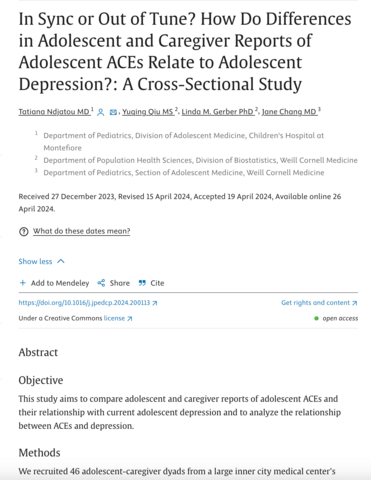Objective:
This study aims to compare adolescent and caregiver reports of adolescent ACEs and their relationship with current adolescent depression and to analyze the relationship between ACEs and depression.
Methods:
The authors recruited 46 adolescent-caregiver dyads from a large inner city medical center's adolescent medicine clinic. Adolescents and caregivers completed the Center for Youth Wellness ACE questionnaire, encompassing traditional ACEs (e.g., abuse, neglect, household dysfunction) and non-traditional ACEs (e.g., foster care, parental death, exposure to community violence). Adolescents also completed the PHQ-9A depression screening tool.
Results:
Among adolescents, 14 (30%) reported no traditional ACEs, 11 (24%) reported one, and 21 (46%) reported more than one. Regarding non-traditional ACEs, 16 (35%) reported none, 11(24%) reported one, and 19 (41%) reported more than one. Caregiver reports consistently indicated lower ACEs compared to adolescent self-reports (p < .005). For the PHQ-9A scores, 26 (57%) of adolescents showed no or minimal depression, 14 (30%) mild, and six (13%) moderate depression. A moderate positive correlation emerged between PHQ-9A scores and self-reported traditional ACEs (rs=0.5, p<.001) and non-traditional ACEs (rs=0.49, p<.001). Additionally, a positive correlation was observed between the absolute differences in adolescent and caregiver reports of traditional ACEs and PHQ-9A scores (n=46, ρ=0.51, p<0.001).
Conclusion:
As the differences in ACE reports between adolescents and caregivers increased, there was a corresponding increase in adolescent depression scores. It is essential to incorporate comprehensive ACE screening and encourage open communication between adolescents and caregivers which may improve mental health outcomes.

